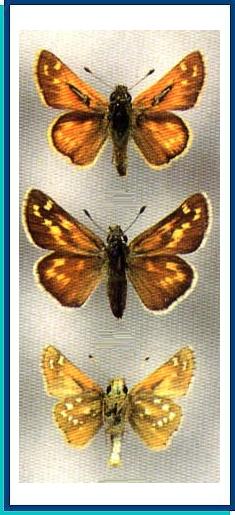LEPIDOPTERA
H E S P E R I I D A E Latreille, 1809
HESPERIA Fabricius, 1793
Hesperia comma (Linnaeus, 1758)
|
Hesperia comma (Linnaeus, 1758) • TYPE LOCALITY. Sweden. • RANGE. From NW. Africa across Europe and temperate Asia to SW. China, the Amurland and the Chukot Peninsula; N. America. • DISTRIBUTION AND VARIATION. The European part, the whole Caucasus, mountains of Middle Asia from Kopet-Dagh to Dzhungarsky Alatau, Saur and Tarbagatai Mts., Siberia and the Far East from the Altai Mts. to the Chukot Peninsula, Kamchatka and Sakhalin. A highly variable species, with a lot of forms described. The bulk of the range is inhabited by the nominate subspecies. In Transcaucasia (the Armenian Highland), the ssp. pallida Staudinger, 1901 has been found; the ssp. mixta Alpheraky, 1881 has been described from Middle Asian mountains (Tian-Shan), and the ssp. shandura Evans, 1949 from an adjacent territory (Chitral). Further three subspecies have recently been described from Siberia: ssp. lena Korshunov et P. Gorbunov, 1995 (Yakutia, the NW. Chukot Peninsula); ssp. planula Korshunov, 1995 (W. Siberia); and ssp. sushkini Korshunov, 1995 (the Altai, Sayan, N. Baikal). The status of the latter trio requires clarification. • TAXONOMIC NOTES. The status, nomenclature and distribution of the numerous, especially Asiatic, forms of the species require a reassessment; the whole H. comma complex is currently being revised. • HABITATS AND BIOLOGY. Forest edges, meadows, open slopes and other open grassy habitats up to 3,900 m a.s.l. in the mountains. Flight period: June-September in different localities, in a single generation. Larvae feeding (Henriksen, Kreutzer, 1982; etc.) on various grasses (Poa, Festuca, etc.); there is also a record of Coronilla varia (Fabaceae) as a host plant (Kumakov, Korshunov, 1979). Hibernation as eggs. • SIMILAR SPECIES. Ochlodes sylvanus: FW broader, UPS ground colour light tawny, UNH pale spots less strongly contrasting. H. florinda: UNH ground colour reddish-tawny or ochreous, pale spots faint or absent. Photo and text: Guide to the BUTTERFLIES OF RUSSIA and adjacent territories Volume 1. PENSOFT, Sofia - Moscow. 1997 |
Hesperia florinda (Butler, 1878)
Hesperia florinda (Butler, 1878)

• TYPE LOCALITY. "Japan".
• SYNONYMS: repugnans Staudinger, 1892; mikado Leech, 1895.
• RANGE. E. Asia from Transbaikalia to Korea and Japan.
• DISTRIBUTION AND VARIATION. Transbaikalia, the Amur and Ussuri regions. Variable in development of the UPS dark coloration and UNH pale spots. The ssp. rozhkovi Kurentzov, 1970, described from Transbaikalia, may be possibly reffered to this species.
• TAXONOMIC NOTES. See H. comma.
• HABITATS AND BIOLOGY. Steppe habitats, grassy sea-shore meadows and slopes, forest edges. Flight period: July-August. In Japan (Fukuda et al., 1984), larvae have been recorded on Carex,
• SIMILAR SPECIES. H. comma: UNH greenish with pale spots fully developed. Ochlodes venatus: FW broader, ground colour light tawny.
Photo and text: Guide to the BUTTERFLIES OF RUSSIA and adjacent territories Volume 1. PENSOFT, Sofia - Moscow. 1997
